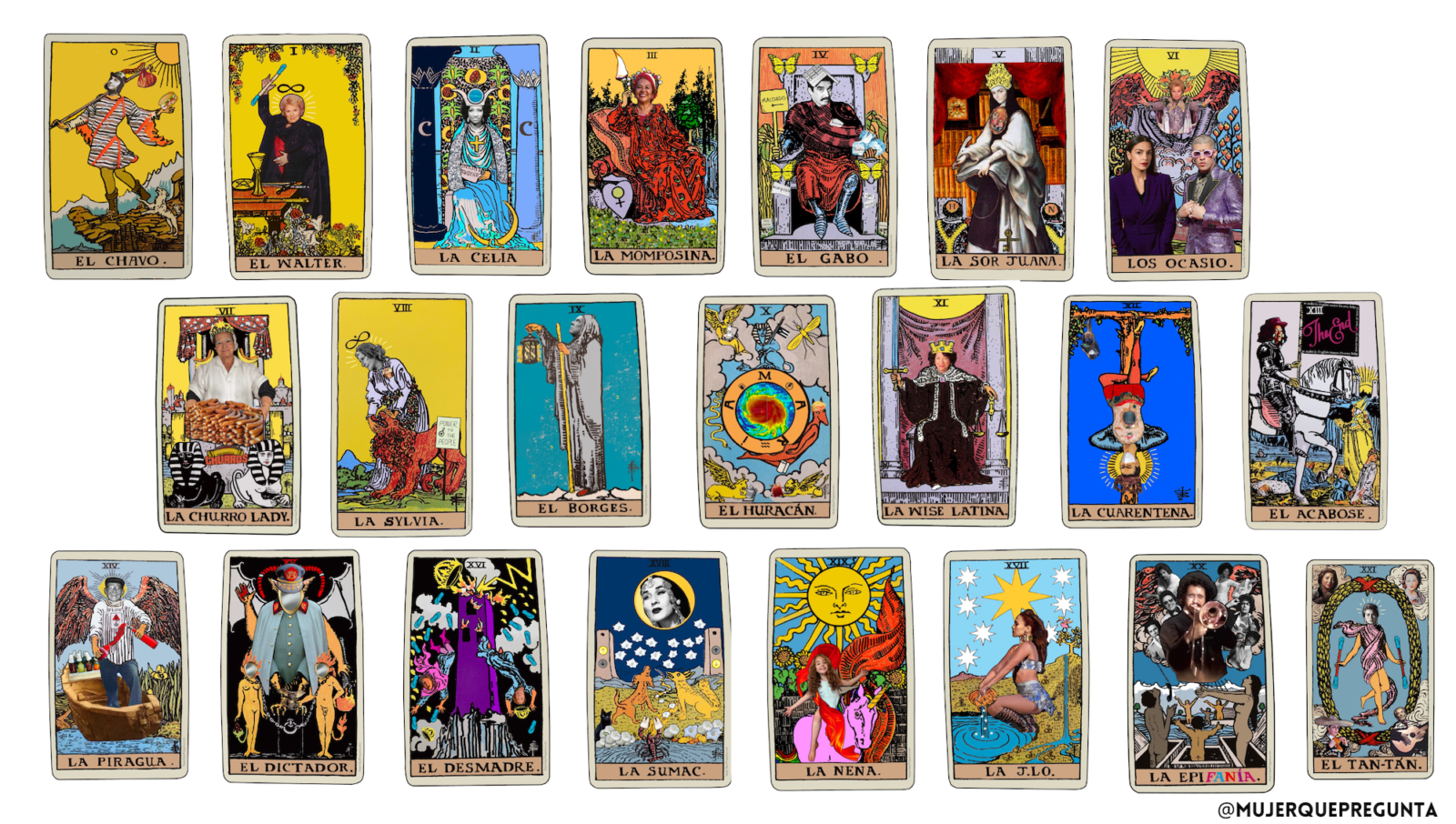
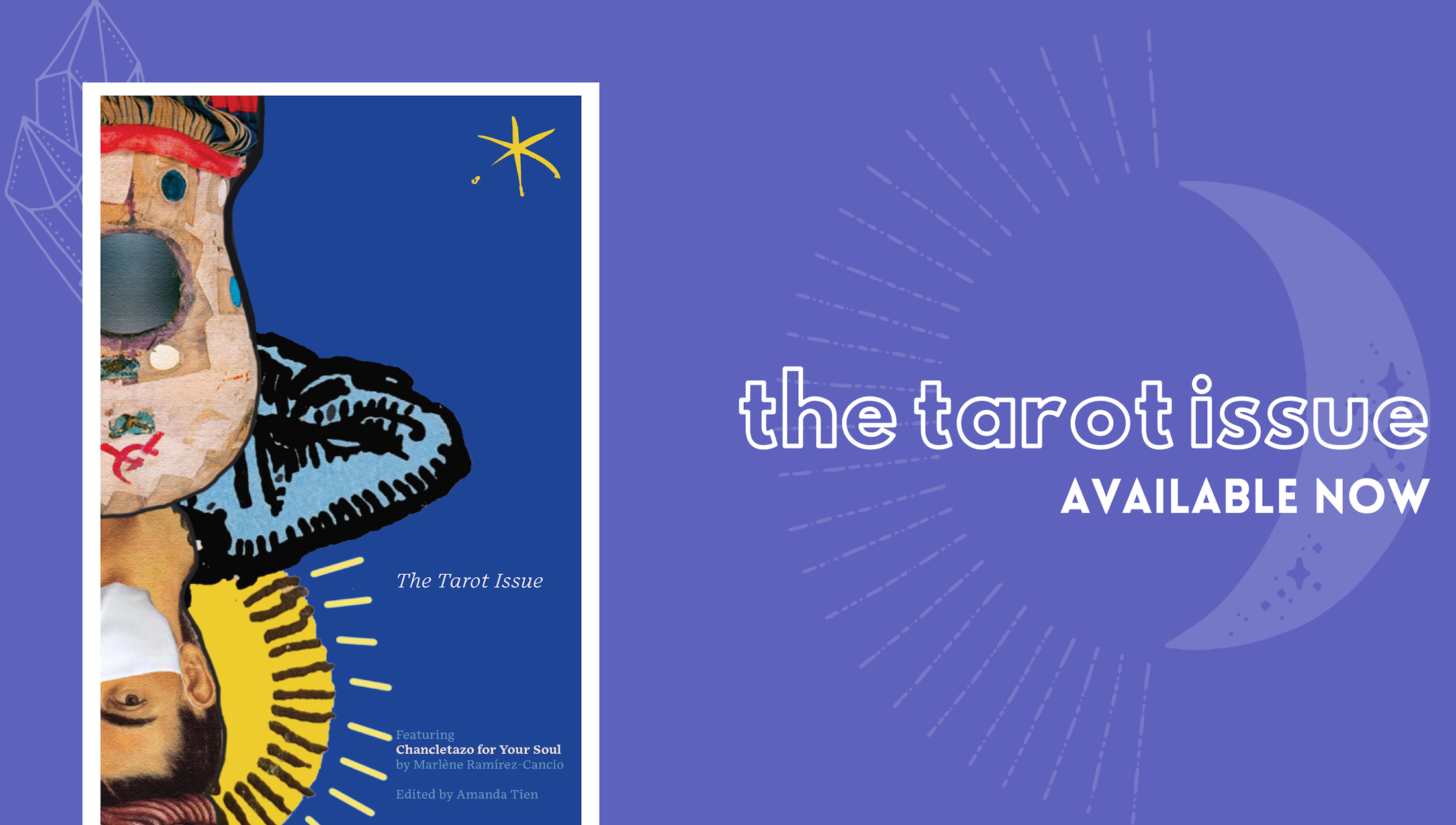
The Tarot Issue features Chancletazo for Your Soul by Marlène Ramírez-Cancio, and is now available to purchase via Amazon.com, Bookshop.org, and Blue Sketch Press.
NEED A Chancletazo? Think of a number between 0-21 and GET YOUR READING!
LA INTRODUCCIÓN
Somebody needed a nudge.
In May 2020, deep in the pandemic, Angie Cruz asked Marlène Ramírez-Cancio to do a tarot reading for someone who needed a push in the right direction. It was a gift, from one woman of color to another. Marlène joked the reading was a “chancletazo for the soul.”
During tarot readings, Marlène found herself frequently referencing Latinx cultural icons and concepts when sharing the Major Arcana. So, for fun, she began to experiment with visual art by adding collage to the widely used 1909 Smith-Rider-Waite deck.
Angie soon introduced Marlène to Aster(ix)’s Managing Editor, Amanda Tien. Aster(ix) then established an Artist-in-Residence feature—for which Marlène was the inaugural resident artist. Amanda re-posted these cards on @asterixjournal every few weeks as Marlène made them from Fall 2020 onwards. In Fall 2022, Amanda suggested this special all-color issue to feature Chancletazo for Your Soul from start-to-finish.
We are proud and honored of the collaborative nature of this work. Aster(ix) exists to lift up others. We hope you enjoy–and don’t forget to ask yourself The Big Questions.
Amanda Tien, Editor of The Tarot Issue & Angie Cruz, Aster(ix) Editor-in-Chief
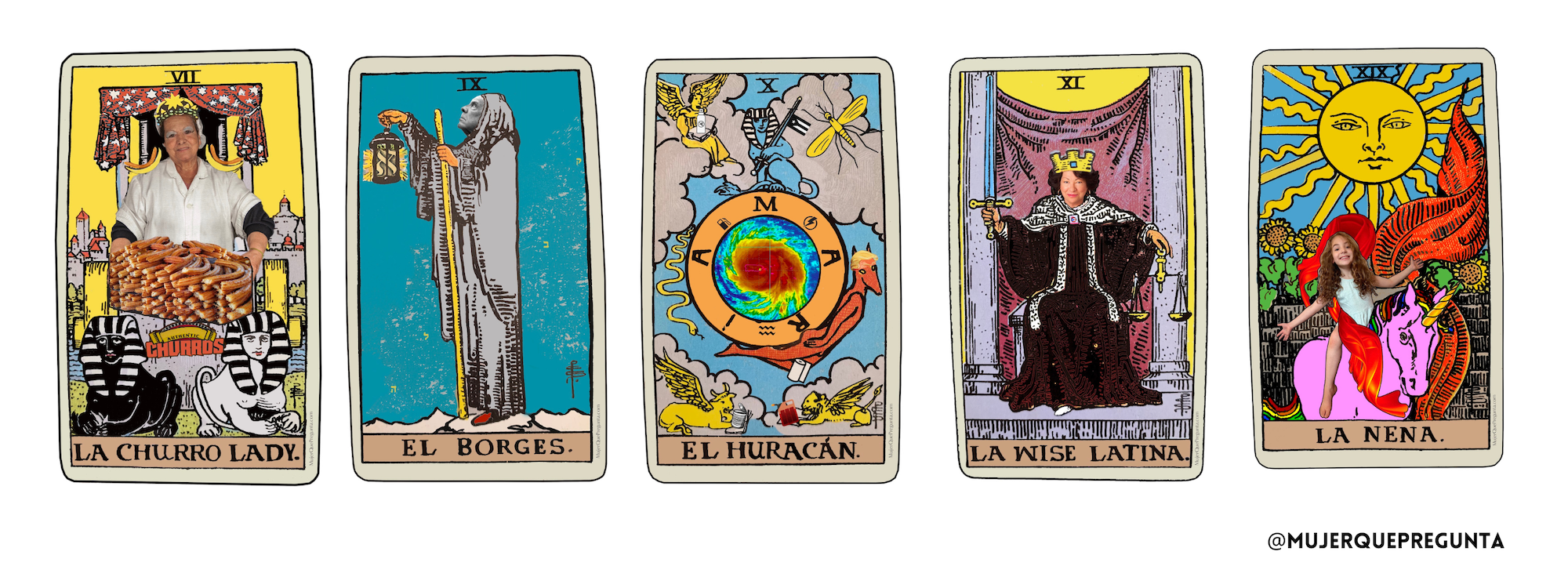
THE CARDS
Chancletazo for Your Soul was born in practice, resulting in the following beautiful and powerful rendition of collage and words of the Major Arcana by Marlène Ramírez-Cancio. If you’re interested in learning more about this project and the behind-the-scenes, please continue on to read a conversation between Marlène and Amanda.
The Chancletazo for Your Soul Major Arcana is not a new version of the tarot—a deck of cards with associated meanings originating in Italian courts hundreds of years ago. Rather, this deck and book are meant to add a layer of new meaning to existing cards. For those of us who know these cultural and societal figures already, it adds enrichment to our understanding. For those who don’t know them, we hope it adds a joyful new lens.
This project features only the Major Arcana. When Major Arcana cards are pulled in a reading, participants are being asked to reflect on the big questions—the major, archetypal experiences—of our journey in this life. In these “strange and trying times,” we all need a bit more of that, do we not?
We also want to note an approach to reversals, which is when a card is drawn upside-down. Marlène shares that reversals should be seen not as a bad omen or as the “opposite” of the card’s meaning, but as useful signs: they are questions about what we are resisting, what we’re afraid of, what’s blocking us, or what we’re not aligned with. Consider what you need to do to turn a card the right side up.
Get started with O. El Chavo
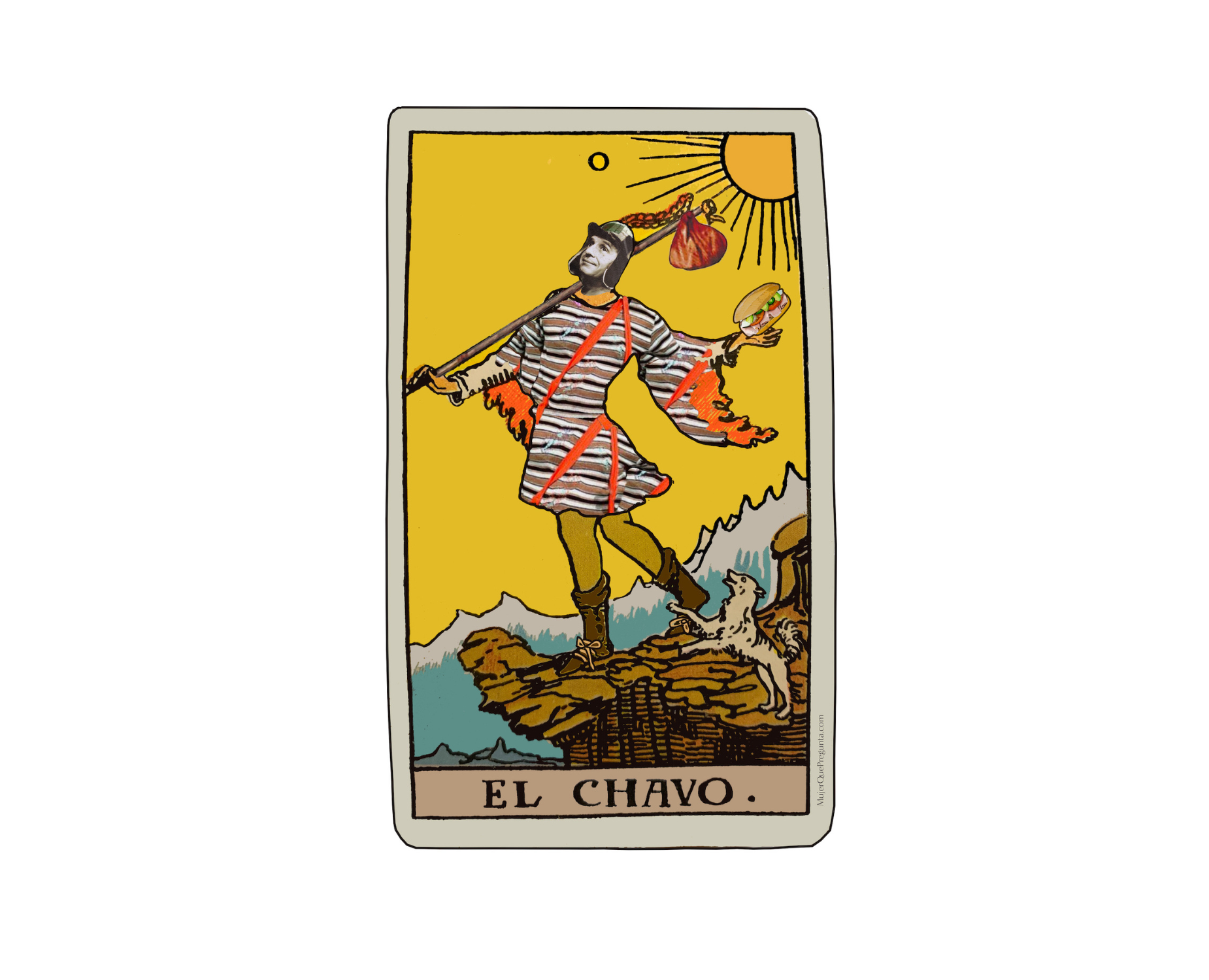
View all cards by clicking here.
THE PLAYLIST
Each card features a song to fit the mood and message of the writing. This playlist includes a few songs for each card, in order. Enjoy!
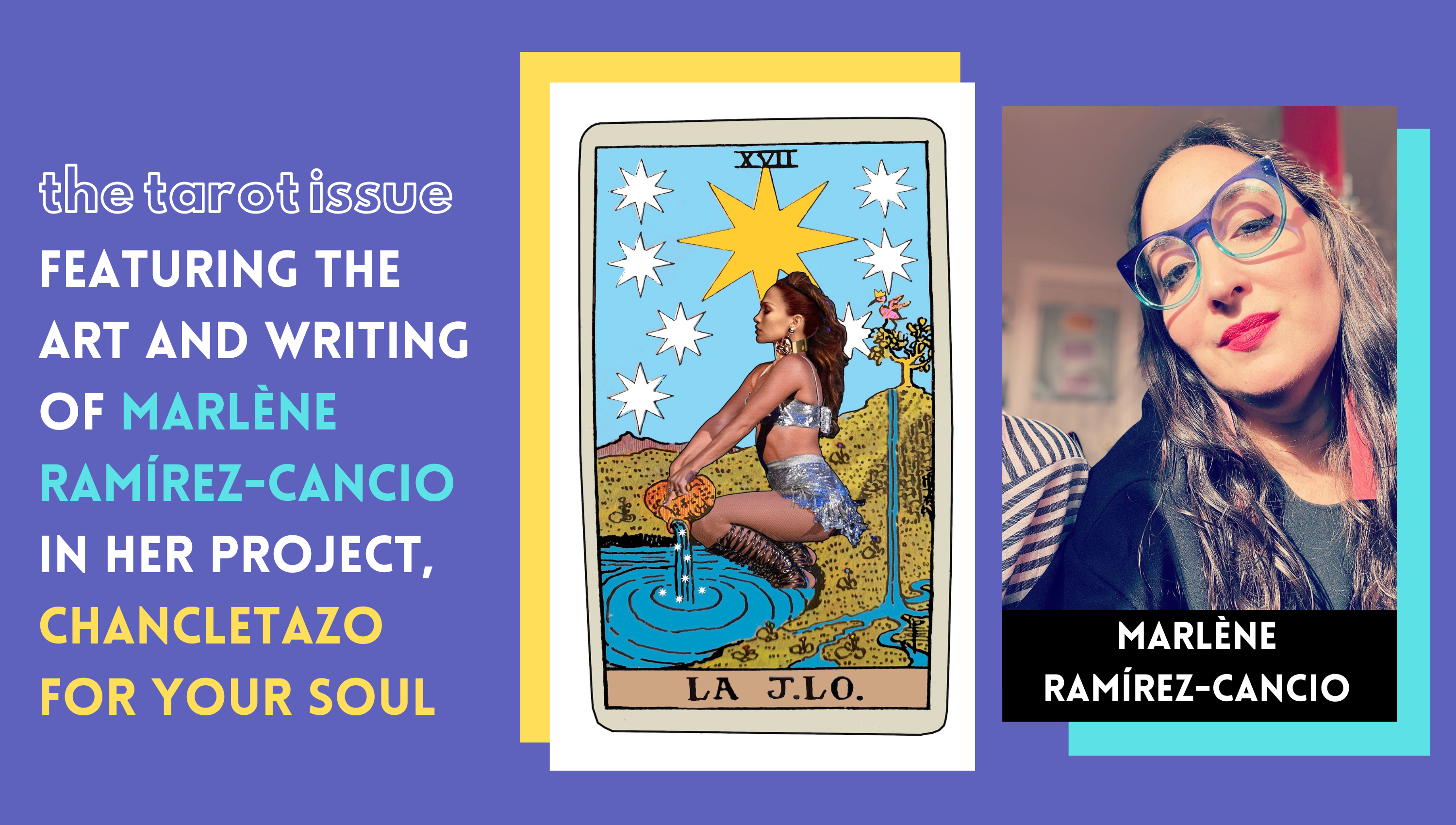
LA CONVERSACIÓN
Amanda Tien (AJT): You did it! You’ve been making this project for close to two years!
Marlène Ramírez-Cancio (MRC): We did it! I really do feel that. If I didn’t have the container of the Aster(ix) artist residency, and especially the loving support from you and Angie Cruz, I never would have finished Chancletazo for Your Soul, punto. This work was and is collaborative.
AJT: Tarot was first invented in Italian courts in the 15th century, and has evolved with usage and meaning. Today, many people use tarot as a way of constructive conversation, a kind of therapy. The cards then become helpful visual reminders to distill big ideas and complicated situations. How did you start to become involved with tarot and doing readings for people?
MRC: I can’t remember the exact moment I first picked up tarot cards, but I saw from old diaries that I was reading them for myself in college. In the early pandemic, I did a reading on Zoom for Angie Cruz, and then she wanted to have me do one for a friend. Mujer Que Pregunta (my tarot and Process Doula practice) began as a gift from one woman of color to another.
Readings are a very intimate experience, and because it was a time when it was impossible to be together in person, we had to find other ways to connect. People allowed themselves to be more vulnerable, I think. Many of my readings were for artists whose livelihoods had been upended by the pandemic, so they were very big questions to explore. How do I survive? What do I really want? What should I do next? What opportunities does this give me?
AJT: Angie gifted me a tarot reading session with you when I started officially as Aster(ix) Managing Editor because she knew I was feeling worried about finishing my first novel. My conversation with you crystalized and named so many things. I still have the cards you pulled for me pinned up by my desk. You are really, really good at doing readings. It was one of the most singularly effective and beautiful conversations I’ve ever had. So, first, thank you, again. And two, what is the experience like for you on the other side?
MRC: I so appreciate you sharing that with me. I’ve learned something surprising about myself as I’ve done more of these. I get very invested in those one-hour conversations. I even get goosebumps when I hear someone say something that is clearly so very true for them, something that perhaps they are just realizing aloud for the first time. I find myself being so in it, so attuned to their little moments. But afterwards—it’s weird—I forget what was said. I wouldn’t have believed it. It’s like I channel things in the moment of hyper-intense connection. But if I didn’t take photos of the readings or follow up with notes, whatever I said during a session would just disappear. My mind just puts it away.
So I’m really grateful to you for the chance to memorialize this project and this process so I don’t forget it, haha! I keep coming back to the hashtag #ThePandemicMadeMeDoIt which I used to add at the end of my instagram posts, because Chancletazo For Your Soul really maps my own Fool’s journey—my own El Chavo journey—through the pandemic, from one job to another, one life stage to another.
AJT: I think that’s why we were so excited to have La Cuarentena as the cover of the issue, too, yes?
MRC: Yes! The Hanged Man Card came up often in my readings over the last few years–I started calling it the Pandemic Card.
AJT: I got that one too!
MRC: Aha, yes! It’s a forced repose, a forced pause from which new illumination and perspective can come. So that cover I think felt like a natural choice to both of us for so many reasons.
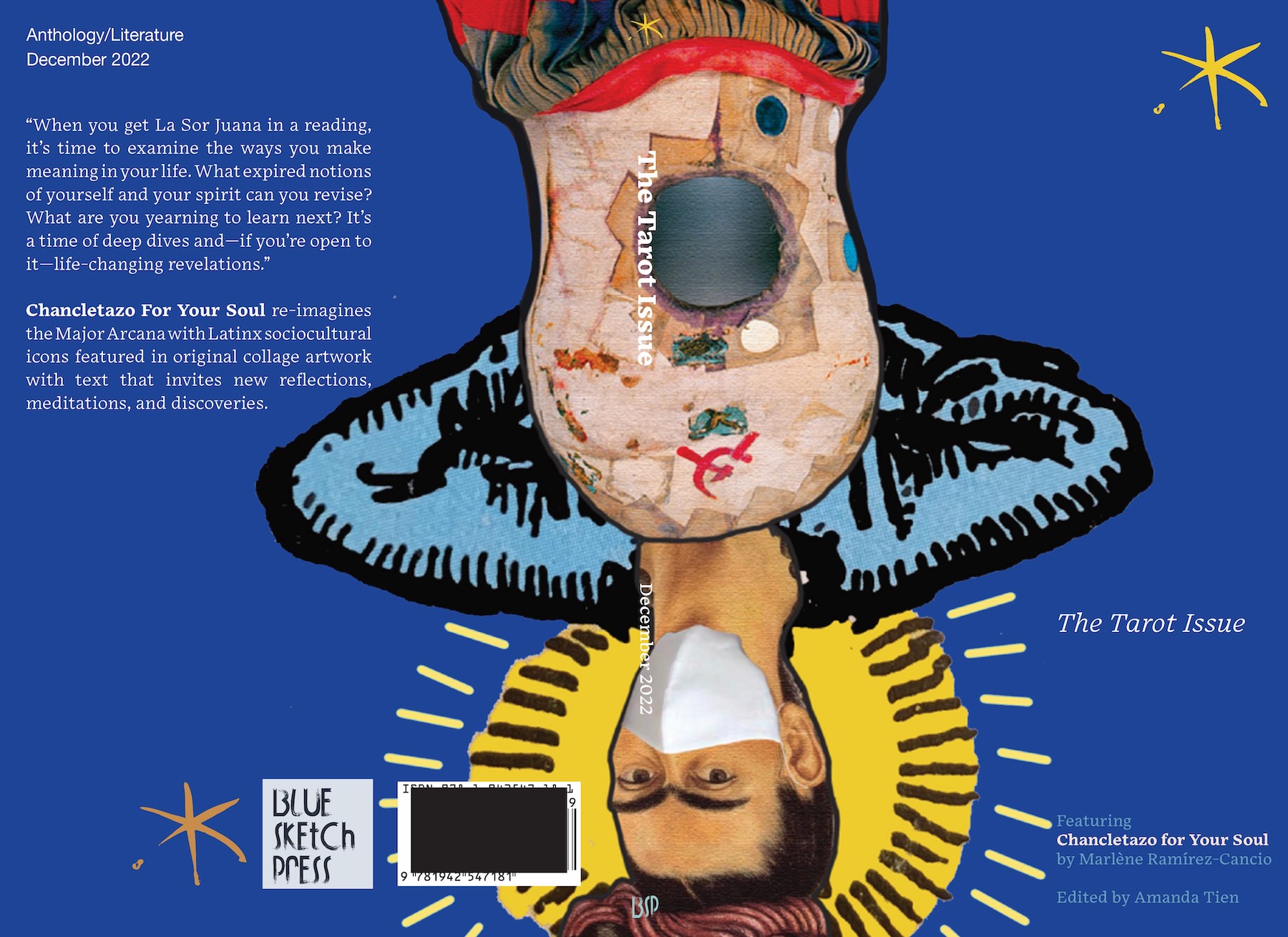
For me, on the other side of tarot readings, there’s a lot of love. It’s sincere love for others and what they’re going through as people. This hardcore cheerleading Process Doula conversation with pretty tarot pictures condensed into one hour. It’s beautiful. I get so much out of it, I learn so much.
AJT: Like what?
MRC: I learn from the things that repeat. They repeat in two different ways: 1) How cards repeat for the same person, and how the deck seems to be almost yelling at them across time and space that they bring up the same cards over and over, saying hey! pay attention! and 2) the repetition of issues from person to person. I can tell you, for example, that almost everyone has said something about impostor syndrome. Everyone thinks it’s them. They say, “I am not…, why am I not…” and I want to say, “Que no panda el cúnico [don’t panic], que pretty much everyone is feeling that!”
I’m not a therapist, but reading tarot has really given me an appreciation for how we’re all connected and how we all have childhood trauma, unresolved issues, and secret dreams, and how these things keep affecting us as grown people—especially as women/femmes of color. We just need reminders sometimes. Mujer Que Pregunta comes from a phrase in Spanish that means, “A woman who asks is a woman who (already) knows.” So even you keeping those cards up on your wall—they’re reminders; you already have those answers within you.
AJT: Ooh, which brings me to the title of the project. Can you share about that?
MRC: Yes! So, a chancletazo refers to the way that Latina moms or grandmas would spank your butt with a flip-flop (a chancleta or chancla) to get you to pay attention or to scold you. It’s an iconic cultural reference, and the subject of much retrospective humor. Por cierto: I’ve struggled with the violent implications of the title, because, who really wants to endorse a spanking? Not me. I mean it as a loving nudge, a call to attention, paying homage to the rubber chancla. And then a Zen practitioner told me about the concept of the “Zen slap,” startling you into shape, into recognizing something, into awakening you to something. And to me that’s the same thing. Y mira—if a slap can be Zen, then I can have my chancletazo and laugh about it too.
In practice, the concept came to me when I pulled reversed cards for people during readings, like say, an upside down Empress or Sun. I’d ask them, “What kind of chancelatzo”—and I’d tap the card with my finger to rotate it—“do you need to turn this card right side up?” The question always made people laugh, then get quiet and think. I see this nudge as a way to help people be most attuned and empowered by their ideals. It’s not meant to sting, it’s not meant to hurt. It’s meant to align you to yourself. And it’s meant to be a little funny.
I’ve done a lot of satire and parody, so there’s elements of that here too. If you think of that book Chicken Soup for Your Soul, and see Chancletazo for Your Soul as an abuela-style take on self-help… Ves? La Chancla can heal! Also, it seems to be memorable, because I’ve gotten calls from people saying, “Marlène, I was just sitting here obsessing and I need one of your chancletazos.” So it seems useful as an action-image.
AJT: You’ve shared with me before that you sometimes felt like you were just making it up as you went along. I know you taught yourself Photoshop doing this project. When did you start to get that confidence?
MRC: Confidence or carifresquería? Ha! I was always a literature person, and then some years ago a psychic said to me I was a “visual artist.” And I was like yeah right, you’re way off, lady. And when this project started to go really well, I remember Angie called me and said, “See, I told you the psychic was right!” There was a moment after the first six or seven cards that just sort of clicked for me. And it’s made me think, who’s to say that you’re not “that” kind of artist? Don’t let anyone (even yourself) say, “Oh, you’re only allowed to be a visual artist” or “only a fiction writer,” or whatever. Who made you believe that? (That’s me talking to myself.)
I even noticed that a lot of my cards included musicians and were accompanied by songs that were important to me; I really have zero musical knowledge or skill, but yet, musical references came to me. This process was getting myself where I was never meant to be, and finding my place in it—while having fun.
AJT: At the beginning of remaking the Major Arcana, you were specifically creating the collages to share on Instagram. How did creating for social media shape your process?
MRC: I was reading for people and I noticed I kept referencing certain icons from my childhood (like el Chavo del Ocho or Walter Mercado), and so I wanted to share those added layers to share with others. I had been doing readings on Zoom, so I was already doing that work in the digital realm at a distance, and Instagram felt sort of a natural platform to extend the work. El Chavo was the first one, because he carries the same bundle The Fool does—so it was an add-on to reference when explaining The Fool to a Latinx person.
The audience on Instagram that I conjured in my mind was bilingual, so I wrote my captions with some Espanglish, and it was a joyful process. Writing visual descriptions also forced me to reckon with what images were included in the card and why. So the process of writing the visual descriptions became part of writing the text in general. And knowing that people could search for songs immediately and play them lent it this multisensorial experience that I was feeling in myself. It had a visual element, a written element, and then the audio, and it was a way to play and share that multitude. You did a great job leading the way on converting those visual descriptions to the If you didn’t know… sections. And OMAIGÁ! The research you did around the images I took off the internet? Amazing. Thank you, Amanda. I’m your forever fan.
AJT: I learned so much making those! Thank you for sharing.
You are a joy to work with, and I think this kind of work—guided reflections, encouragement, something beautiful, making something out of pieces, and of course the power of tarot to make us think—is exciting. You told me that El Chavo and El Walter came really naturally to you. We’ve been working on the Instagram collaboration of this project going on two years (wow!), and I know that some cards weren’t so easy.
MRC: There were some icons and cultural figures I thought about including in this project, and it was hard to narrow it down! And you know this better than anyone, but it took me a year to get the final two, Judgment and The World. In the Major Arcana, they indicate coming to a place of completion, the end of the hero’s/Fool’s journey. It’s really big emotions, concepts, and I had no idea what in the hell I was going to use for those epic cards. I talked to a LOT of people about it, and bless them for brainstorming with me. Pero in the end, La Epifanía and El Tan-Tán revealed themselves to me while I was resting, lying on my bed doing “nothing,” and they appeared right as the deadline was approaching (how convenient, ha!).
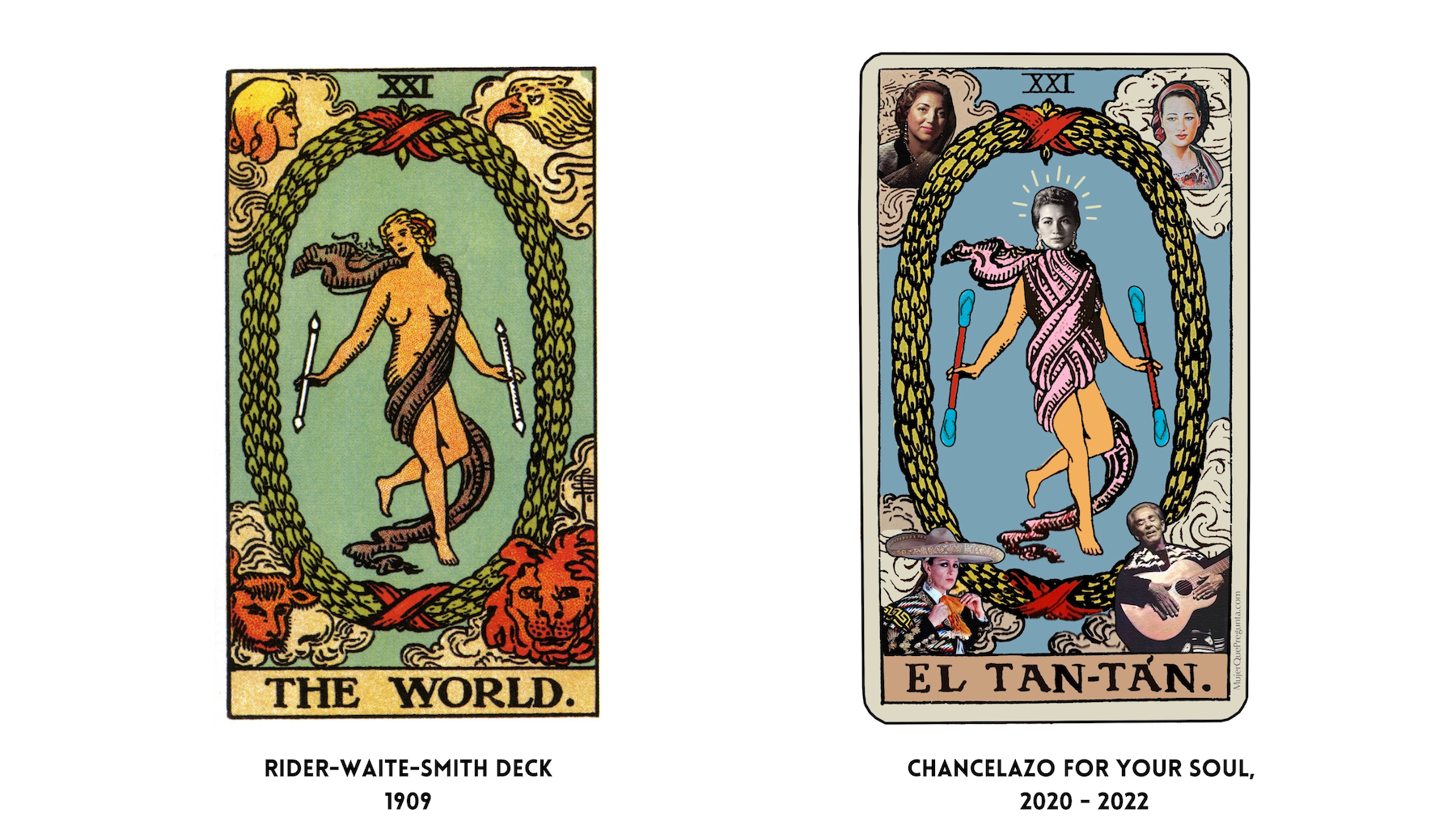
El Tan-Tán is the last card I figured out, but ironically, it has always been with me. Many years ago, in twentieth-century San Francisco, as part of the Latina Theatre Lab collective I was in a show called Last Stop Ranchera. My friend Monica Sánchez, who is an incredible writer and performer, wrote this beautiful opening piece about seeking the genesis of the ubiquitous tan-tán, exploring the question: why do rancheras end with tan-tán? She tracked it to the beating of the heart: Tan-tán, tan-tán, tan-tán. And I have lived with this tan-tán in my own heart ever since. It was like it was the deepest, most ancient card within me in the whole deck, and yet it was the one that was least visible to me as I searched for it. And when I stopped searching for it, it was right there! It was the only possibility for the card of completion, for the ultimate mic drop. And what I like about it is that, yes, while it indicates the end of a song, it means that another song can begin. Like this project, this phase might be over, but now it’s time for the next. It’s an incredibly fulfilling moment. And now we can begin another journey.
el fin
A note regarding collage
This issue features collage based on Pamela Colman Smith’s designs for the 1909 Rider-Waite-Smith tarot deck and images found from the internet and made into new collages (for example, the “image” of Jennifer Lopez on card XVII does not exist in reality – it is a heavy conglomeration of many elements).
We have attempted to list attributions when possible for images (please the print version of the issue for a full list or request via asterixjournal at gmail dot com). We are grateful to be a space to feature the power of collage. We believe this work is protected under the Fair Use Act for the purposes of commentary, criticism, and scholarship. This literary journal is a not-for-profit artistic endeavor to highlight and lift up the creative work of BIPOC womxn from around the world.








